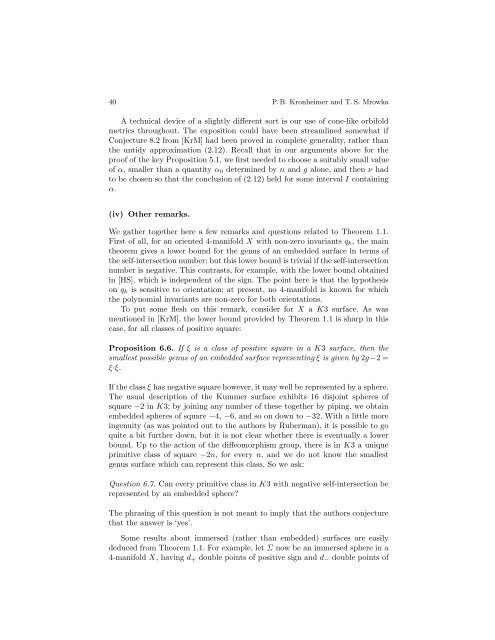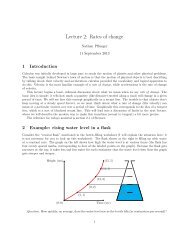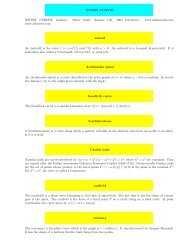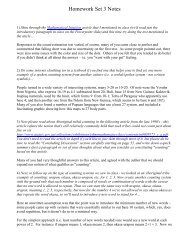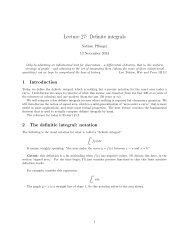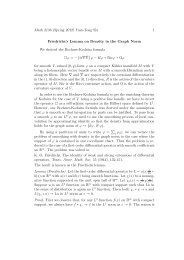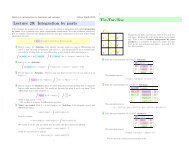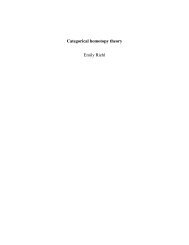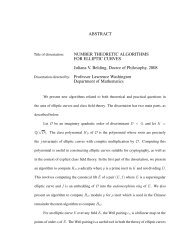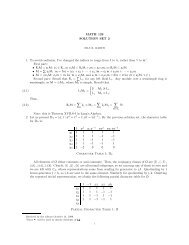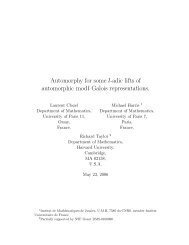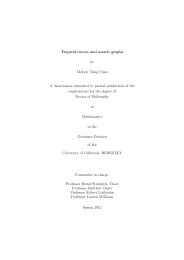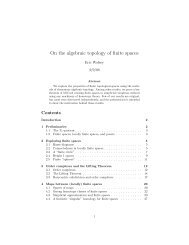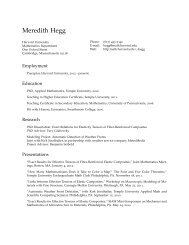Gauge theory for embedded surfaces, II
Gauge theory for embedded surfaces, II
Gauge theory for embedded surfaces, II
Create successful ePaper yourself
Turn your PDF publications into a flip-book with our unique Google optimized e-Paper software.
40 P. B. Kronheimer and T. S. Mrowka<br />
A technical device of a slightly different sort is our use of cone-like orbifold<br />
metrics throughout. The exposition could have been streamlined somewhat if<br />
Conjecture 8.2 from [KrM] had been proved in complete generality, rather than<br />
the untidy approximation (2.12). Recall that in our arguments above <strong>for</strong> the<br />
proof of the key Proposition 5.1, we first needed to choose a suitably small value<br />
of α, smaller than a quantity α0 determined by n and g alone, and then ν had<br />
to be chosen so that the conclusion of (2.12) held <strong>for</strong> some interval I containing<br />
α.<br />
(iv) Other remarks.<br />
We gather together here a few remarks and questions related to Theorem 1.1.<br />
First of all, <strong>for</strong> an oriented 4-manifold X with non-zero invariants qk, the main<br />
theorem gives a lower bound <strong>for</strong> the genus of an <strong>embedded</strong> surface in terms of<br />
the self-intersection number; but this lower bound is trivial if the self-intersection<br />
number is negative. This contrasts, <strong>for</strong> example, with the lower bound obtained<br />
in [HS], which is independent of the sign. The point here is that the hypothesis<br />
on qk is sensitive to orientation; at present, no 4-manifold is known <strong>for</strong> which<br />
the polynomial invariants are non-zero <strong>for</strong> both orientations.<br />
To put some flesh on this remark, consider <strong>for</strong> X a K3 surface. As was<br />
mentioned in [KrM], the lower bound provided by Theorem 1.1 is sharp in this<br />
case, <strong>for</strong> all classes of positive square:<br />
Proposition 6.6. If ξ is a class of positive square in a K3 surface, then the<br />
smallest possible genus of an <strong>embedded</strong> surface representing ξ is given by 2g−2=<br />
ξ·ξ.<br />
If the class ξ has negative square however, it may well be represented by a sphere.<br />
The usual description of the Kummer surface exhibits 16 disjoint spheres of<br />
square −2 inK3; by joining any number of these together by piping, we obtain<br />
<strong>embedded</strong> spheres of square −4, −6,andsoondownto−32. With a little more<br />
ingenuity (as was pointed out to the authors by Ruberman), it is possible to go<br />
quite a bit further down, but it is not clear whether there is eventually a lower<br />
bound. Up to the action of the diffeomorphism group, there is in K3 a unique<br />
primitive class of square −2n, <strong>for</strong> every n, and we do not know the smallest<br />
genus surface which can represent this class. So we ask:<br />
Question 6.7. Can every primitive class in K3 with negative self-intersection be<br />
represented by an <strong>embedded</strong> sphere?<br />
The phrasing of this question is not meant to imply that the authors conjecture<br />
that the answer is ‘yes’.<br />
Some results about immersed (rather than <strong>embedded</strong>) <strong>surfaces</strong> are easily<br />
deduced from Theorem 1.1. For example, let Σ now be an immersed sphere in a<br />
4-manifold X, having d+ double points of positive sign and d− double points of


